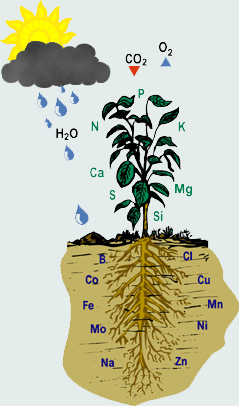
Manganese(Mn)
Manganese is essential to plants but too much is toxic. Manganese functions in chlorophyll development & serves as a catalyst in several enzyme systems in the oxidation-reduction process. Manganese deficiencies are very similar to iron deficiencies & appears in the younger leaves of the plant first. Colour may be pale between the veins of broadleaf plants.
Boron(B)
Boron is vital to the growth & development of the plant. Without adequate Boron, new growth ceases. It is necessary in the pollination & seed production stages. Boron is essential for maintaining a balance between sugars & starches. A small amount of Boron is beneficial to plants but too much can be toxic to plants.
Copper(Cu)
Copper is important as a co-enzyme. It is needed to activate several plant enzymes, including building & converting amino acids to proteins. Since Copper is an immobile nutrient, deficiency symptoms usually occur on new growth. Copper deficient plants will become chlorotic &take on a bleached appearance. New growth may die.
Zinc(Zn)
Zinc is necessary for starch formation & proper root development. It is also essential for seed formation & maturity. The most common nutrient deficiencies include interveinal chlorosis on older leaves with shortening of the intermodal area. This shortening often leaves a short compressed plant with a rosetted appearance.
Molybdenum(Mo)
Molybdenum is required by plants for utilization of nitrogen. Plants cannot transform nitrate nitrogen into amino acids. Without molybdenum legumes cannot symbiotically fix atmospheric nitrogen.*
Iron(Fe)
Iron is required for the formation of chlorophyll in plant cells. It serves as an activator for biochemical processes such as respiration, photo-synthesis and symbiotic nitrogen fixation.*
*Taken from: Western Fertilizers Handbook

